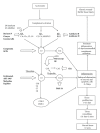Complement activation and inhibition in wound healing
- PMID: 23346185
- PMCID: PMC3546472
- DOI: 10.1155/2012/534291
Complement activation and inhibition in wound healing
Abstract
Complement activation is needed to restore tissue injury; however, inappropriate activation of complement, as seen in chronic wounds can cause cell death and enhance inflammation, thus contributing to further injury and impaired wound healing. Therefore, attenuation of complement activation by specific inhibitors is considered as an innovative wound care strategy. Currently, the effects of several complement inhibitors, for example, the C3 inhibitor compstatin and several C1 and C5 inhibitors, are under investigation in patients with complement-mediated diseases. Although (pre)clinical research into the effects of these complement inhibitors on wound healing is limited, available data indicate that reduction of complement activation can improve wound healing. Moreover, medicine may take advantage of safe and effective agents that are produced by various microorganisms, symbionts, for example, medicinal maggots, and plants to attenuate complement activation. To conclude, for the development of new wound care strategies, (pre)clinical studies into the roles of complement and the effects of application of complement inhibitors in wound healing are required.
Figures


References
-
- Baxter CR. Immunologic reactions in chronic wounds. The American Journal of Surgery. 1994;167(1):S12–S14. - PubMed
-
- Jones SG, Edwards R, Thomas DW. Inflammation and wound healing: the role of bacteria in the immune-regulation of wound healing. Lower Extremity Wounds. 2004;3(4):201–208. - PubMed
-
- Park JE, Barbul A. Understanding the role of immune regulation in wound healing. The American Journal of Surgery. 2004;187(5):11S–16S. - PubMed
-
- Chaby G, Senet P, Vaneau M, et al. Dressings for acute and chronic wounds: a systematic review. Archives of Dermatology. 2007;143(10):1297–1304. - PubMed
-
- Ubbink DT, Westerbos SJ, Nelson EA, Vermeulen H. A systematic review of topical negative pressure therapy for acute and chronic wounds. British Journal of Surgery. 2008;95(6):685–692. - PubMed
Publication types
MeSH terms
Substances
LinkOut - more resources
Full Text Sources
Other Literature Sources
Miscellaneous

